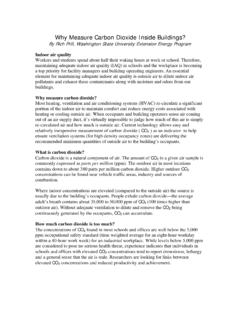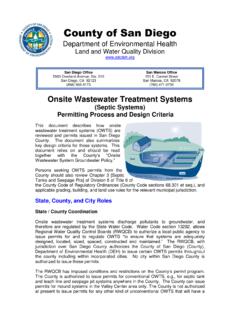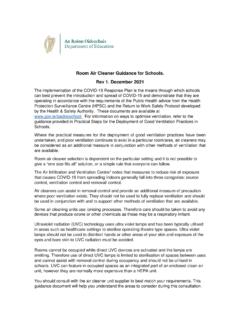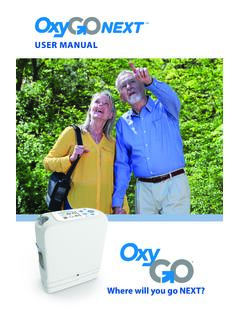Transcription of Kjeldahl method - Food and Agriculture Organization
1 Standard operating procedure for soil nitrogenKjeldahl methodStandard operating procedure for soil nitrogenKjeldahl methodFood and Agriculture Organization of the United Nations Rome, 2021 Required citation: FAO. 2021. Standard operating procedure for soil nitrogen - Kjeldahl method . designations employed and the presentation of material in this information product do not imply the expression of any opinion whatsoever on the part of the Food and Agriculture Organization of the United Nations (FAO) concerning the legal or development status of any country, territory, city or area or of its authorities, or concerning the delimitation of its frontiers or boundaries. The mention of specific companies or products of manufacturers, whether or not these have been patented, does not imply that these have been endorsed or recommended by FAO in preference to others of a similar nature that are not mentioned.
2 The views expressed in this information product are those of the author(s) and do not necessarily reflect the views or policies of FAO. FAO, 2021 Some rights reserved. This work is made available under the Creative Commons Attribution-NonCommercial-ShareAlike IGO licence (CC BYNC-SA IGO; ). Under the terms of this licence, this work may be copied, redistributed and adapted for non-commercial purposes, provided that the work is appropriately cited. In any use of this work, there should be no suggestion that FAO endorses any specific Organization , products or services. The use of the FAO logo is not permitted. If the work is adapted, then it must be licensed under the same or equivalent Creative Commons licence. If a translation of this work is created, it must include the following disclaimer along with the required citation: This translation was not created by the Food and Agriculture Organization of the United Nations (FAO).
3 FAO is not responsible for the content or accuracy of this translation. The original [Language] edition shall be the authoritative edition . Disputes arising under the licence that cannot be settled amicably will be resolved by mediation and arbitration as described in Article 8 of the licence except as otherwise provided herein. The applicable mediation rules will be the mediation rules of the World Intellectual Property Organization and any arbitration will be conducted in accordance with the Arbitration Rules of the United Nations Commission on International Trade Law (UNCITRAL). Third-party materials. Users wishing to reuse material from this work that is attributed to a third party, such as tables, figures or images, are responsible for determining whether permission is needed for that reuse and for obtaining permission from the copyright holder. The risk of claims resulting from infringement of any third-party-owned component in the work rests solely with the user.
4 Sales, rights and licensing. FAO information products are available on the FAO website ( ) and can be purchased through Requests for commercial use should be submitted via: Queries regarding rights and licensing should be submitted to: Soil Laboratory Network GLOSOLAN GLOSOLAN-SOP-14 SOIL NITROGEN Kjeldahl methodVersion number : 1 Page 1 of 21 Effective date : 18 January 2021 Modify by Revision Approved Date Validated Date GLOSOLAN SOP Tech. Global leader: Miriam Ostinelli, Argentina By the Review Panel 18 January 2021 18 January 2021 SOIL NITROGEN Kjeldahl methodVERSION HISTORY N Date Description of the modification Type of modification 01 18 January 2021 All comments by RESOLANs and reviewers to the draft SOP were addressed Finalization of the SOP 02 03 04 Etc. Global Soil Laboratory Network GLOSOLAN GLOSOLAN-SOP-14 SOIL NITROGEN Kjeldahl methodVersion number : 1 Page 2 of 21 Effective date : 18 January 2021 Modify by Revision Approved Date Validated Date GLOSOLAN SOP Tech.
5 Global leader: Miriam Ostinelli, Argentina By the Review Panel 18 January 2021 18 January 2021 Contents 1. Brief introduction to Kjeldahl nitrogen .. 3 2. Scope and field of application .. 3 3. Principle .. 4 4. Apparatus .. 4 5. Materials .. 4 6. Health and safety .. 6 Personnel safety .. 6 Chemical hazard .. 6 7. Sample preparation .. 6 8. Procedure .. 7 Digestion .. 7 Distillation and titration .. 8 Spectrometric quantification .. 10 9. Calculation .. 10 10. Quality assurance/Quality control .. 11 Precision test .. 11 Trueness test .. 11 Control chart .. 12 11. References .. 13 12. Appendix I. Spectrometric quantification (indo-phenol blue method ) .. 14 13. Appendix II. Acknowledgments .. 18 14. Appendix III. List of authors .. 18 15. Appendix IV. Contributing laboratories .. 18 Global Soil Laboratory Network GLOSOLAN GLOSOLAN-SOP-14 SOIL NITROGEN Kjeldahl methodVersion number : 1 Page 3 of 21 Effective date : 18 January 2021 Modify by Revision Approved Date Validated Date GLOSOLAN SOP Tech.
6 Global leader: Miriam Ostinelli, Argentina By the Review Panel 18 January 2021 18 January 2021 introduction to Kjeldahl nitrogenNitrogen (N) is considered the most important nutrient in Agriculture due to its key role in the formation of proteins, DNA, RNA, etc. Soil nitrogen is present in organic or inorganic forms. The organic fraction constitutes most of the N in the soil (more than 95 percent of the total N) and is mainly composed of plant and microbial remains. The inorganic fraction (less than 5 percent of the total N) comprises ammonium ions (NH4+), nitrate (NO3-) and very little nitrite (NO2-). The organic fraction of N is a measure of the nutrient reserve in the soil and an indicator of its ability to release N through mineralization, so the analysis of N in soils dedicated to agricultural activity is useful for making decisions about the management of N nutrition in crops.
7 Monitoring N dynamics in soils is also important from an environmental perspective, since NO3- is one of the main pollutants in groundwater and surface waters, whilst nitrous oxide as a by-product of NO3- application is a contributor to poor air quality and Greenhouse Gas emissions. The analysis method used to measure soil N will define the fraction of N to be quantified. The organic N plus a fraction of inorganic N, which is in the form of NH4+, is commonly called total N (for the high percentage that both fractions represent) or Kjeldahl N (KjN), and are measured using the Kjeldahl method . This method includes a wet digestion of the soil sample to mineralize the N to NH4,which will be distilled and measured. The inorganic forms of N (NH4+, NO3- and NO2-) are generally determined by distillation or colorimetry of a soil extract, but N-NO3 can also be measured by potentiometric methods .
8 The advantages of this method are based on its robustness, low initial cost of the equipment and extensive application. However, there are disadvantages in using this method compared to others, for example, the use of potentially hazardous reagents that require consideration for safe operation are utilized, alongside the generation of hazardous waste and on-going cost of consumables, which can be mitigated via modified protocols that use lower quantities of reagents. Another limitation of this method is that it measures organic N and mineral N in the form of NH4+, therefore, to measure the total N, the mineral N in the form of NO3- must be measured separately. and field of applicationThis standard operating procedure (SOP) describes, in general terms, the quantification of the KjN content in soil samples. The method allows the quantification of N in the form of NH4+ and organic N.
9 Nitrate and nitrite are not included. Compounds N-bonding (N-N, N-O and heterocycles, especially pyridine) are not digested entirely. For most soils, the Kjeldahl method achieves a good estimate of the total N content of the soil. A typical limit of detection is N, and a typical limit of quantification is N, however, this varies with the characteristics of the equipment used. This SOP is applicable to all types of soils. Global Soil Laboratory Network GLOSOLAN GLOSOLAN-SOP-14 SOIL NITROGEN Kjeldahl method Version number : 1 Page 4 of 21 Effective date : 18 January 2021 Modify by Revision Approved Date Validated Date GLOSOLAN SOP Tech. Global leader: Miriam Ostinelli, Argentina By the Review Panel 18 January 2021 18 January 2021 procedure involves the digestion of a soil sample, the distillation of the NH3 produced and its quantification by titration (or colorimetry).
10 The soil is digested in concentrated sulfuric acid, in the presence of a catalyst mixture that allows the boiling temperature to be regulated, until complete dissolution and oxidation. The organic N contained in the sample is oxidized to ammonium (as ammonium sulphate). The NH4+-N in the digest is quantified by collection of the NH3 liberated by steam distillation of the digest with alkali and titrated with a volumetric acid solution. If the quantification of nitrates is required, some modifications can be included that enable the reduction and transformation of this anion into ammonium, for example, with the addition of salicylic acid (not included in this SOP). laboratory equipment and: Balance to three decimal points - g. Analytical balance to four decimal points - g. Digestion unit or block-digester, suitable for digestion of samples with sulphuric acid at 390 C 10 C, with fume extraction system.













